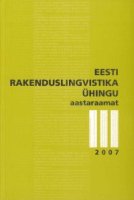Pronoomenid lapsekeeles: mõnda mina ja sina omandamisest
Pronouns in child language: some fragments of a study of the acquisition of the pronouns mina and sina by Estonian children
Author(s): Maigi VijaSubject(s): Language and Literature Studies
Published by: Eesti Rakenduslingvistika Ühing (ERÜ)
Keywords: child language acquisition; pronouns; input; Estonian
Summary/Abstract: The article focuses on the acquisition of Estonian personal pronouns mina 'I' and sina 'you' by children at the age of 1;7–3;1 and compares the children’s usage with the input they receive. The spontaneous speech data of Estonian children in the CHILDES database were analysed. The main analysis is based on Andreas’s 76-hour recorded corpus. The results show that demonstrative pronouns tend to appear before personal pronouns. The usage of personal pronouns is accidental and sporadic at the beginning. When speaking about themselves, children use their own name with the 3rd person singular verb form. They also hear such constructions a lot in the input. Estonian data suggest that the way that a mother speaks with the child is related to the child’s age, i.e., a three-year-old would be spoken to in more adult-like language than a two-year-old. There are nearly 3000 instances of the short and long forms of the 1st person singular personal pronouns mina/ma (functioning as the subject) in Andreas’s language. The 2nd person singular personal pronouns occur three times less frequently. Compared to the input, Andreas uses the long forms of the 1st and 2nd pronouns more than does his mother. Children often make mistakes in their early use of pronouns,; e.g they tend to mix up the 1st and 2nd person pronouns. It is difficult for a child to understand the shift in the reference of a pronoun in conversation. That is why children use the 2nd person singular pronoun sina when speaking about themselves. Personal pronouns do not appear very early in the language of Estonian children. The first to appear are the primary deictic forms (mina, sina); their numbers are higher than those of other forms both in the language of the child and the mother.
Journal: Eesti Rakenduslingvistika Ühingu aastaraamat
- Issue Year: 2007
- Issue No: 3
- Page Range: 373-384
- Page Count: 12
- Language: Estonian

